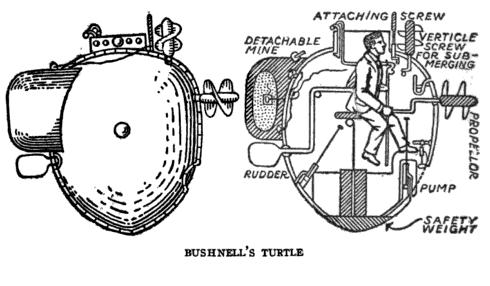HMS Eagle (1774) on:
[Wikipedia]
[Google]
[Amazon]
HMS ''Eagle'' was a British 64-gun
 On 7 September 1776, the experimental American submarine , under the guidance of army volunteer Sergeant
On 7 September 1776, the experimental American submarine , under the guidance of army volunteer Sergeant
third-rate
In the rating system of the Royal Navy, a third rate was a ship of the line which from the 1720s mounted between 64 and 80 guns, typically built with two gun decks (thus the related term two-decker). Years of experience proved that the third r ...
ship of the line of the Royal Navy
The Royal Navy (RN) is the United Kingdom's naval warfare force. Although warships were used by English and Scottish kings from the early medieval period, the first major maritime engagements were fought in the Hundred Years' War against ...
, launched on 2 May 1774 at Rotherhithe
Rotherhithe () is a district of south-east London, England, and part of the London Borough of Southwark. It is on a peninsula on the south bank of the Thames, facing Wapping, Shadwell and Limehouse on the north bank, as well as the Isle of D ...
.
History
 On 7 September 1776, the experimental American submarine , under the guidance of army volunteer Sergeant
On 7 September 1776, the experimental American submarine , under the guidance of army volunteer Sergeant Ezra Lee
Ezra Lee (August 1749 – October 29, 1821) was an American colonial soldier, best known for commanding and operating the one-man ''Turtle'' submarine.
Early life and career
Lee was born in Lyme, Connecticut. On January 1, 1776, he enlisted in ...
, was alleged to have attacked HMS ''Eagle'', which was moored off what is today called Liberty Island
Liberty Island is a federally owned island in Upper New York Bay in the United States. Its most notable feature is the Statue of Liberty (''Liberty Enlightening the World''), a large statue by Frédéric Auguste Bartholdi that was dedicated i ...
, but was unable to bore through the hull. When Lee attempted another spot in the hull, he lost the ship, and eventually abandoned the attempt.
British naval historian Richard Compton-Hall stated that the problems of achieving neutral buoyancy
Neutral buoyancy occurs when an object's average density is equal to the density of the fluid in which it is immersed, resulting in the buoyant force balancing the force of gravity that would otherwise cause the object to sink (if the body's densi ...
would have rendered the vertical propeller useless. The route ''Turtle'' would have had to take to attack HMS ''Eagle'' was slightly across the tidal stream which would, in all probability, have resulted in Ezra Lee becoming exhausted having only 20 minutes of air. There is no record of the Royal Navy recording an attack.Compton-Hall, pp. 32–40 In the face of these and other problems Compton-Hall suggests that the Turtle got nowhere near HMS ''Eagle'' and the entire story was fabricated as disinformation and morale-boosting propaganda, and that if Ezra Lee did carry out an attack it was in a covered rowing boat rather than ''Turtle''.
''Eagle'' went on to take part in the Battle of Cuddalore in 1783.Winfield 2007, p. 105
''Eagle'' was on harbour service from 1790, and was broken up in 1812.
Notes
References
* Lavery, Brian (2003) ''The Ship of the Line - Volume 1: The development of the battlefleet 1650-1850.'' Conway Maritime Press. . *External links
* Ships of the line of the Royal Navy Intrepid-class ships of the line 1774 ships {{UK-line-ship-stub